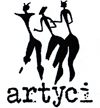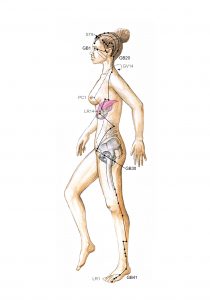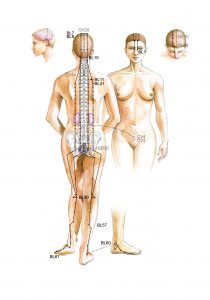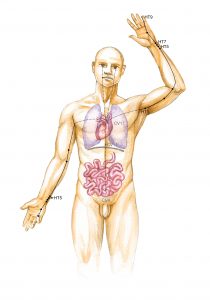Written by_ Zuna Vesan 2017
Translated by_Žubra Žubretovská 2021
In my pedagogical practice I have been working in improvisation with meridians for years. I feel in them a huge well of unusual movement possibilities, which I also offer to my students. Working with meridians through movement is also an excellent way to feel the flow of Qi in your own body, as well as a good way to remember their pathways. Remember them not only by the mind, but by immersion in physical memory. One can look at certain meridian in a picture and learn the pathway according to it, but there is nothing better than experiencing them on one’s own body, when each cell encodes them through movement. Last but not least, working with meridians in movement improvisation can be a medicine. I offer the results of this work in my book TAO OF MOVEMENT.
In this blog, I offer a look at two yang channels – the gallbladder and bladder meridian and one yin channel – the Heart meridian. You can also see the beutifull pictures of those channel painted by my friend and student Peter Žuffa used in my book MERIDIANS PATHWAYS OF LIFE. First you get some information about the meridian itself and then a text about the possibility of working with it in motion.
The gallbladder channel is a yang pair channel, running along the right and left sides of the body, from top to bottom. At the picture it is shown only on one side. It is specific because it is the only channel that leads through the sides of the body. Its Qi begins at the outer corners of the eyes. It continues to the ears, encircling them on the sides with three semicircular arches, thus covering almost the entire head. It continues along the lateral parts of the neck through the upper trapezoids. It leads towards the shoulders and armpits. In the area of the trunk, it connects with the gallbladder and liver through its internal branches. It passes through the sides of the ribs towards the pelvis. From there, it penetrates deep into the hip joints. From there, the inner branch connects with the bladder channel in the sacrum. It descends along the sides of the thighs, through the sides of the knees and calves, continues under the outer ankles and leads along the insteps to the fourth toes, where it ends at the nail beds on the outer sides of these toes. Its main branch has 44 acupuncture points. On the instep, Qi is poured from this channel into the liver channel.
The gallbladder channel affects all problems along its pathway, such as hip pain, pain in all lower limb joints, rib pain, temples pain, headache, migraines, ear disorders, armpit swelling. It greatly helps the smooth flow of liver Qi and the smooth flow of emotions. It helps to permeate the retained emotions, which are transformed into material formations in the bile ducts and gallbladder. In the psychological field, it is also related to the ability to make decisions.
Gall-bladder channel in movement
The channel offers many possibilities for movement experiments, as it is one of the longest and the most diverting channels and runs from head to toe, leading mainly along the sides of the body. For movement improvisation, use the sides of the body – the sides of the head, temples, sides of the neck, ribs, outer upper ends of the femurs (large trochantors), iliotibial tracts, knees, calves, feet. Look for the movement possibilities of these parts of the body.
Conscious focus on the sides of the body will nicely expand your entire body and at the same time the ability to see peripherally. Trust it and thus use less forward-looking movement. Gallbladder Qi is also related to the ability to see peripherally. The path begins at the outer corners of the eyes, hence supporting this ability. You can also play with copying the movement of someone else in the group with your peripheral vision.
An interesting feature of the channel for movement is its connection with the ears. In improvisation, let us be guided by sound, open our ears, sharpen our hearing and perceive how this work affects the movement of the whole body and how it activates the purity of hearing. Working with this channel really activates our hearing and thus purifies it so that we can use our hearing more and not leave most of our perception to the eyes.
When we work in motion with the ribs, the spaces between them open beautifully, the intercostal muscles relax, and Qi can flow better in this area. With this movement, it also provides an internal massage to the organs, but also to the thoracic spine. As the channel penetrates into the depth of the hip joints, we intensively engage these joints in motion. Let the movement come from the hip joints and observe where in the body will reach the impact of such movement. Will it be the ribs, the neck, or even the head? Let’s also focus on the hip joints and their energetic connection with the sacrum. Let us observe what perception such movement brings to the body.
The channel also passes through the iliotibial tract, which is located on the sides of the thighs and which ensures the stability of the knees. Let’s improvise with the iliotibial tract, realize the stability of the knees and look for new possibilities of movement from the knees.
We can also work with the fourth toes, for example, by guiding the movement of the entire lower limbs from them.
The gallbladder channel is connected to the extraordinary Belt vessel – Dumai, which opens the way to the periphery, but also to rotation. Let us improvise with rotation from the center of gravity of the body, realizing the connection with the channel of the gallbladder.
After prolonged improvisation, Qi is strongly activated in the channel. Let’s enjoy this flow of Qi in motion and at the same time its yang charge.
The bladder meridian is the body’s longest pathway. It is a pair pathway, with a yang charge, Qi descends through it from top to bottom. It begins in the inner corners of the eyes, emerges to the head, where Qi flows through the inner branch into the brain. It continues through the crown and nape to the neck, under the 7th cervical vertebra it connects with other yang paths. An immense field of its action takes place on the back, passing along the spine, in four streams of Qi flow. Here, Qi is connected to the nerve processes from the spinal cord, so it affects all organs that connect the nerves to the brain. It is also directly connected to the bladder and kidneys by the internal branches. It descends from the torso to the back of the lower limbs, continues through the back of the thighs, below the knees and to the calves. In the ankle area, it meets the Achilles tendons and on the outside of the feet, Qi flows to the little fingers, where it ends and connects with the Qi of the kidney pathway. There are 67 active acupuncture points on this pathway.
The pathway relates to the bladder itself and the problems associated with it, for example: urinary problems including incontinence and urinary retention. Thanks to the connection with the protrusions of the nerves from the spinal cord, it has an impact on all organs. In connection with the kidneys, it also has an effect on bone diseases including osteoporosis, some forms of arthritis, tooth decay, premature hair loss or graying, hearing loss and dizziness, lower back pain and weakness, and so on. As the only pathway, it has a large number of acupuncture points, through which we can act on other pathways. Therefore, it is one of the most important pathways of the body. At the mental level, it affects the ability to accurately perceive reality, the ability to integrate experiences, and the will to live.
Bladder meridian in motion
Due to the length of this pathway and the number of areas of the body through which it passes, the pathway offers us many possibilities for movement. As it passes along the spine, working with it has a significant effect on the entire paravertebral system and the nervous system. In the movement we focus on working with the spine, various wavy movements are suitable, imitating, for example, the movement of a snake or seaweed floating in calmly moving water. We can even work specifically with the image of wakame algae, which also resembles the shape of the spine. The gentle undulating movement of the spine from side to side helps to increase the spaces between the vertebrae, which revitalizes the vertebrae and intervertebral discs. It is advisable to rub the sacrum well with the palms, which will pleasantly warm it up.
Movement using the flow of Qi in this pathway also affects the brain. It is an excellent stimulant. We can also involve the eyes at which the path begins. We can either guide the movement with our eyes and the participating eyesight, or we can actively observe everything around us as we move around the space. For movement improvisation, it is very interesting to connect the eyes with the little toes on the feet, where the tracks end. This way of using the pathway in motion helps to realize the relationship between the eyes and the feet, between sight and walking. When we work with both ends of this pathway at the same time, Qi is activated evenly throughout this long section. Working with this pathway in motion also helps the back thigh muscles. We usually have them in everyday life, so to speak, “forgotten”, which causes their permanent withdrawal. Activating Qi in these areas of the thighs during movement is a good way to pleasantly fill them with new fresh Qi. The result will be better elasticity.
The same applies to the back of the knees and the Achilles tendons. The bladder pathway is part of the chain of muscles that connect the Achilles tendon with the muscles of the thighs and spine. This chain is clamped to the back of the skull. Working with it therefore affects the condition of the Achilles tendon, but also vice versa – the condition of the Achilles tendon will affect other segments of this chain, thus the muscles of the back and the entire bladder pathway.
Let’s also enjoy the connection of the yang charge of the pathway, advancing from top to bottom, with the yin charge of the Earth.
The heart channel is a yin pair channel, leading from the chest along the inside of the arms to the little fingers. I the picture is shown on both sides. It starts in the heart and is divided into 3 branches. The first passes through the diaphragm and connects the heart to the small intestine. The second protrudes through the esophagus and heads into the eye, making way for the Shen’s spirit to radiate through the eyes. The third branch leads to the armpit, where the surface main branch emerges to the surface of the body, the skin, at its first point. It runs along the inner backs of the upper arms through the elbows and forearms. In the wrist area, the qi is slightly dense. It penetrates the palms and ends at the nail bed of the little fingers from the thumb side. In the area of the hands, it connects with the small intestine channel . The heart is also called the “lotus flower with nine gates”, which indicates that this path has 9 acupuncture points.
The channel relates to the heart muscle itself, affects heart disease and circulatory problems, palpitations, arrhythmias, etc. As well as speech disorders, including stuttering. It also has an influence on excessive sweating, especially at night. It affects the spirit, helps to calm nervousness, affects sleep.
Heart meridian in motion
The channel, with its yin essence and shorter length, offers us immersion in subtlety. However, the lines of the little fingers on the inner sides of the arms offer an interesting, not very common use. When we work with it it has an effect on the opening of the axiliary area (armpits). The pathway begins in the heart, at the depth of the chest, and leads to the arm. This deep source helps to integrate the arms with the center of the chest and, in fact, with the whole body, and in addition to using the chest to move the arms and vice versa.
Interesting for movement is the use of the inner areas of the elbows, where the channel asses. Making the movement through these areas helps to fully open the flow in this path, while physically feeling how qi flows automatically from the elbows to the little fingers.
The track also passes through the palms and ulnar sides of the wrists (on the side of the little fingers), which we can discover and activate in movement improvisation. It also includes the pectoral muscles and the sides of the upper ribs, which we also consciously involve in movement. It will beautifully open our chest, which will help us create more space for the heart, a little loosen of its grip in the chest, which happens during normal functioning.
The inner branch of the channel leads to the eyes, which gives us the opportunity/ability/possibility to engage the eyes, sight and conscious look in the movement. When we move with a conscious look for a while, the heart seems to be filled with this consciousness and the space which the movement creates for it.
After longer improvisation, qi is strongly activated in the channel. Let’s enjoy this flow of Qi.
Translation of this text is supported by Slovak Art Concil




